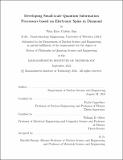Developing Small-scale Quantum Information Processors based on Electronic Spins in Diamond
Author(s)
Sun, Won Kyu Calvin
DownloadThesis PDF (14.08Mb)
Advisor
Cappellaro, Paola
Terms of use
Metadata
Show full item recordAbstract
Isolated optically-active solid-state spins such as the Nitrogen-Vacancy (NV) center in diamond have demonstrated good properties as qubits for quantum information tasks. However, engineering larger quantum registers around a central NV enables more powerful applications. For example, a register of nuclear spins around the NV has already demonstrated many quantum protocols such as quantum error correction and entanglement distillation. Still, thanks to their stronger coupling to the NV and external fields, a register of electronic spins would enable new complementary applications, such as quantum enhanced sensing and scalable architectures for quantum computation.
In this thesis, three critical steps are demonstrated toward the goal of developing a small-scale quantum information processor based on electronic spins in diamond.
First, we develop a method to systematically scale up a system of electronic spins starting from one qubit – the optically-addressable NV – by characterizing the Hamiltonian of nearby optically-dark electron-nuclear spin defects in its microscopic environment. The knowledge of the system Hamiltonian, which characterizes spin defects in the solid, further enables coherent control over the system.
Second, we characterize the quantum register of electronic spins with respect to two important aspects: entanglement and decoherence.
As entanglement is critical to many quantum information tasks, an accurate characterization of entanglement generated by a quantum device is desired. Therefore, to improve upon the conventional entanglement witness based on the state fidelity, we develop a new metric, called the subspace witness, that is more robust in the presence of local unitary control errors. The subspace witness, at the cost of additional measurements, is insensitive to any combination of single-qubit phase errors accrued during the state-preparation-and-measurement of the target entangled state.
Furthermore, as the power of quantum devices is limited by decoherence, a practical (i.e., classical) and predictive noise model for the device is desired. As the first step to characterize the coherence of a multi-qubit register, we demonstrate a method to build a self-consistent classical noise model for individual qubits. For the NV qubit, well isolated from the bath, it is possible to develop a self-consistent model, which not only characterizes the bath but can help develop more robust quantum gates and circuits. However, for a nearby qubit, this is not possible due to a possibly a more complex and quantum bath for this qubit – which, after future investigation, may further scale up the size of the quantum register.
Finally, to demonstrate the potential advantage of an electronic spin register, we implement a quantum information task in sensing of external fields. The electronic spins serve to enhance the sensitivity not only via entanglement, but also through a repetitive readout scheme. This result paves the way towards practical quantum advantage in sensing.
The methods and results presented in this thesis outline a path toward developing small-scale quantum registers based on electronic spins in diamond and demonstrate their practical applications to enhance a broad range of tasks in quantum information processing.
Date issued
2021-09Department
Massachusetts Institute of Technology. Department of Nuclear Science and EngineeringPublisher
Massachusetts Institute of Technology